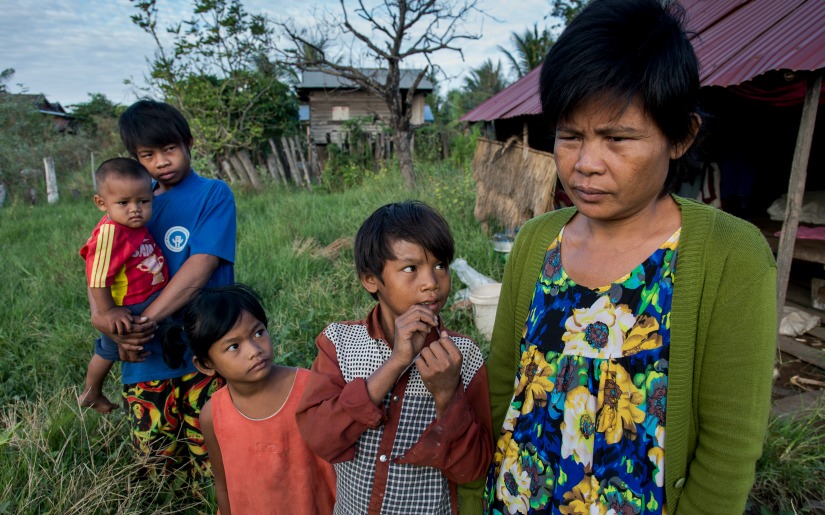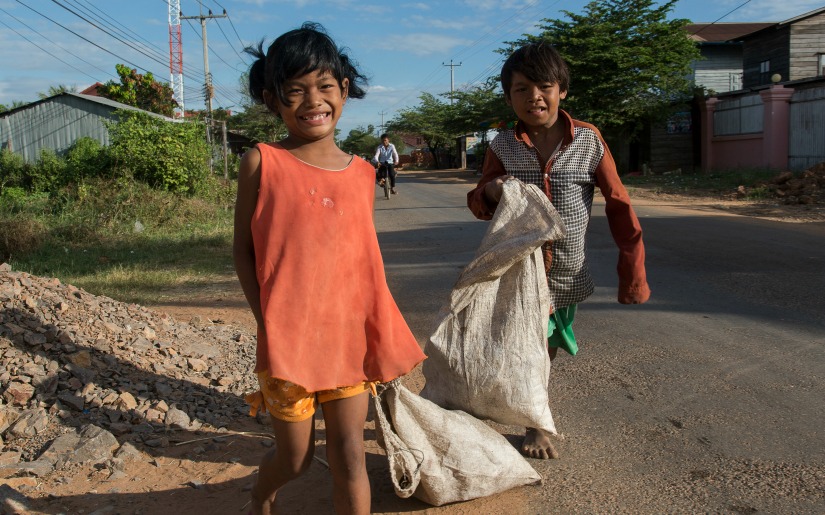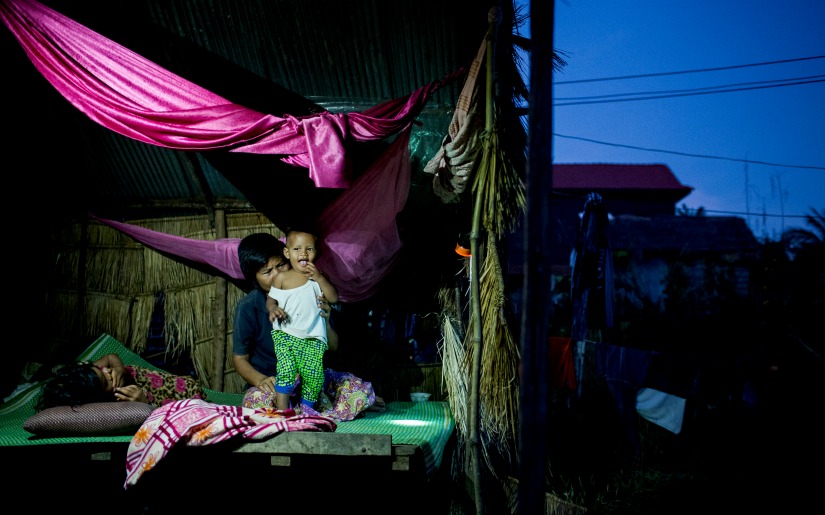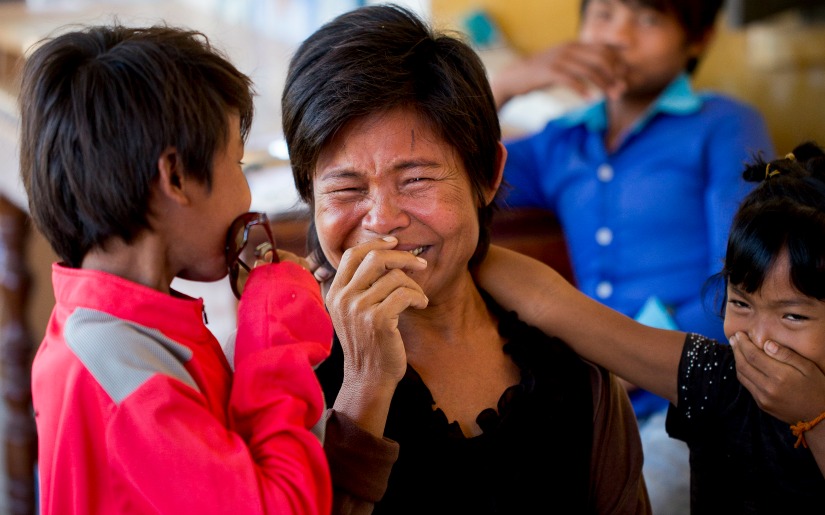
We’ve seen many heart-breaking examples of avoidable blindness, but Thol and her family were one of the most devastating. What's incredible is how fast her life turned around.
It’s 9am in Samrong, in the Oddar Meanchey province of Cambodia. Children are riding their oversized bikes along the highway on their way to school. The girls wear white shirts with navy skirts – and boys wear the same white shirts, with neat little navy ties. Two young figures walk in the opposite direction.
One is eight-year-old Thas and the other is her 13 year-old brother Jay. They both drag a large, woven plastic bag behind them, half full of bottles and cans. They’ll collect rubbish from the side of the street until their bags are full. “That’s around 20c worth,” we’re told. ”And they’ll keep doing this for another three hours or so until they can make around $1.”

Children fighting to survive
Thas collects rubbish as though it’s a game. There is a playful spring in her step when she spots a plastic or glass bottle worth picking up. But this isn’t a game. This is her life. This is her survival.
Meanwhile, over the other side of town, Thas and Jay’s 17- year-old brother Chang is standing on the edge of a nearly dry river with a fishing net in his hand. He’s trying to catch a fish or two for his family to add to the boiled rice they’re lucky to eat each day.
For the past year Chang has been the head of his household, responsible for his family’s financial survival. His youthful face bares the stresses of a man twice his age. He fondly remembers his only year of school and says if life were kinder, he’d like to be an engineer. But life hasn’t been kind - and education was a luxury his family simply couldn’t afford.
The children’s mother Thol sits idly on a raised wooden platform inside her home, which is only about 3x3 metres. There are no walls in her home, just straw tied to sticks covering about a third of the space where walls should be. Eight thin bamboo poles hold up a collection of tin scraps forming a roof.

Reliant and helpless
She is helpless – marooned on her platform - unable to move without the eyes and guidance of her children. The 46-year-old has been totally blind for a year and a half. Her cataracts are like tiny, white sequins in her eyes, blocking out her surrounds. Her husband didn’t want a blind wife, so he left her when she was pregnant with Cheet. He took all the family’s money.
During three months of the wet season, her home sometimes floods up to her knees, making the raised bed platform more isolated than it already is. She worries all day that her youngest child will crawl off the platform into the water. Although she’s never seen Cheet’s face, she knows every inch of his body and reaches out for any part of him to hold onto.
When the rain is really heavy, everyone gets wet. It pours through the open home on an angle and leaks through one of the many gaps in the roof. Thol and her family huddle close together and cover themselves with a large piece of plastic.
A vulnerable situation
Young Thas is now at a vulnerable age. This is a part of Cambodia where child trafficking is a threat. There are signs around everywhere pointing out this terrible fact. Thol arranges her children on the platform at night to protect her daughter. The two boys lay on the outside of the platform closest to the edge. If anyone accosted their fragile home, they would need to fight past the boys to reach their younger sister.
Thol explains she hasn’t had her eyes fixed because she didn’t know her condition could be treated. Even if Thol had known her cataracts could be removed, services in Oddar Meanchey Province are frighteningly few. There are no ophthalmologists here.
Finding an eye doctor is not easy
Eye services only really began in 2011, when The Fred Hollows Foundation renovated the local hospital, donated some essential equipment and began conducting outreach eye camps. These eye health shortages aren’t unique to Oddar Meanchey - in fact in a country of over 15 million people, there are just 34 practicing ophthalmologists.
To get your eyes fixed in Cambodia the first thing you need to do is find an eye doctor and in Oddar Meanchey, you need to wait for The Foundation to bring that eye doctor to you.
Thol is lucky that Dr Sarath who was trained by The Fred Hollows Foundation and his surgical team are in town. They are ready to help Thol for a quick and easy operation to restore her sight.
In less than 15 minutes, the operation is over. Thol sits up assisted by the nurses. In an incredible gesture of gratitude, she places her hands together to thank the staff before she’s even left the table.

Years of misery are close to an end for Thol. The next day after the operation, Dr Sarath is ready to remove the eye patches of Thol. The children gather around her hoping to be the first one that Thol sees. Dr Sarath slowly removes her bandage.
There’s a pause for a moment as Thol’s first reaction is to keep her eyes shut. But then she opens them and almost instantly comes to life in a bursting smile. She thanks the doctor again and then turns to face her children and counts them one by one.
She reaches out to touch baby Cheet’s face as if to match what she can now see, with what she’s always been able to feel. She’s asked what Cheet looks like and she says, happily, ”He’s fat!” After the second operation to fix her left eye, Thol’s vision was completely restored. It was hard to tell if she was laughing or crying.
These days, Thol is able to make a living growing and selling fish in the market, and the kids no longer have to fend for themselves. Through a relatively straightforward operation, their mother has been liberated from the darkness. She’s been given back opportunities that were once taken away so cruelly. Giving people that chance, that choice – that independence and dignity, is exactly why the work of The Fred Hollows Foundation matters so much.